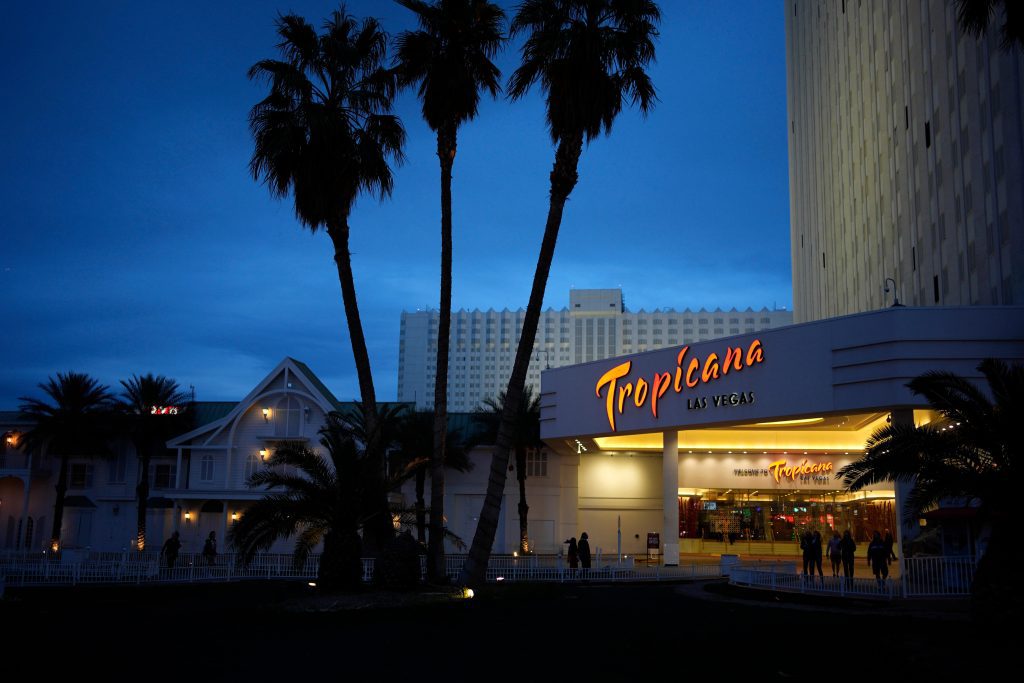By RIO YAMAT (Associated Press)
LAS VEGAS (AP) — In the 1971 movie “Diamonds are Forever,” James Bond stays in a luxurious room at the Tropicana Las Vegas.
“I hear that the Hotel Tropicana is quite comfortable,” Agent 007 says.
It was the Tropicana’s prime time. The extravagant casino was often visited by the famous Rat Pack, while its past linked to the mob solidified its position in Vegas history.
However, after welcoming visitors for 67 years, the doors to the Las Vegas Strip’s third-oldest casino will be closed at noon Tuesday and the building will be demolished in October to make space for a $1.5 billion Major League Baseball stadium — part of the city’s latest transformation into a center for sports entertainment.
“It’s time. It’s ran its course,” Charlie Granado, a bartender at the Tropicana for 38 years, said of the casino’s closure. “It makes me sad but on the other hand, it’s a happy ending.”
The population of Clark County, which includes Las Vegas, had just surpassed 100,000 when the Tropicana opened on a Strip surrounded by vast, open desert. It cost $15 million to build three stories with 300 rooms split into two wings.
Its well-maintained lawns and stylish showroom earned it the nickname “Tiffany of the Strip.” There was a tall tulip-shaped fountain near the entrance, mosaic tiles and mahogany-paneled walls throughout.
Monochrome photos from that time give a glimpse into the interior of the Tropicana at its peak, when it frequently hosted top-tier stars in its showroom — from Elizabeth Taylor and Debbie Reynolds to Frank Sinatra and Sammy Davis Jr.
Mel Tormé and Eddie Fisher performed at the Tropicana. Gladys Knight and Wayne Newton have held residencies there.
In a city known for transformation, the Tropicana itself went through major changes as Las Vegas developed. Two hotel towers were added in later years. In 1979, a $1 million green-and-amber stained glass ceiling was installed above the casino floor.
Barbara Boggess was 26 when she started working at the Tropicana in 1978 as a linen room attendant.
“The Tropicana was pretty much sitting here all by itself,” Boggess said. “It was desert all around. It used to take me 10 minutes to get to work. Now it takes an hour.”
Now 72, Boggess has seen the Tropicana through its many iterations. There was the 1980s rebrand as “The Island of Las Vegas,” with a swim-up blackjack table at the pool, and the South Beach-themed renovation completed in 2011.
Today, only the low-rise hotel room wings remain of the original Tropicana structure. Yet the casino still brings up vintage Vegas nostalgia.
“It does give an old Vegas vibe. When you first walk in, you see the stained glass and the low ceilings,” JT Seumala, a Las Vegas resident who visited the casino in March, said. “It does feel like you step back in time for a moment.”
Seumala and his husband stayed at the Tropicana as a way to pay tribute to the landmark. They roamed the casino floor and hotel, turning down random hallways and exploring the convention center. They tried their luck at blackjack and roulette and made conversation with a cocktail server who had worked there for 25 years. At the end of their stay, they pocketed a few red $5 poker chips to remember the casino.
In the background of the casino’s opening many years ago, the Tropicana was connected to organized crime, mostly through reputed mobster Frank Costello.
Several weeks after the big opening, Costello was shot in the head in New York. Police discovered in his jacket pocket a piece of paper with the exact earnings of the Tropicana. The note also mentioned the money to be stolen for Costello’s associates, according to a post on The Mob Museum’s website reflecting on the Tropicana’s history.
During the 1970s, federal authorities investigating mobsters in Kansas City accused over a dozen mob members of plotting to steal nearly $2 million in gambling revenue from Las Vegas casinos, including the Tropicana. Charges related to the Tropicana alone led to five convictions.
However, the famous hotel-casino also experienced many years of success without mob involvement. It was home to the city’s longest running show, “Folies Bergere.” The topless show, brought from Paris, showcased what is now one of the most famous Las Vegas symbols: the feathered showgirl.
During its nearly 50-year run, “Folies Bergere” displayed intricate costumes and stage sets, original music that at one time was played by a live orchestra, line dancers, magic shows, acrobats and comedy.
The cabaret was portrayed in the 1964 Elvis Presley film “Viva Las Vegas.” Magicians Siegfried Fischbacher and Roy Horn began their careers in the show.
Presently, the location at the south end of the Las Vegas Strip crosses with a major road named after the Tropicana. It is surrounded by the towering megaresorts that Las Vegas is now known for.
However, nearby are the residences of the NFL’s Las Vegas Raiders, who relocated from Oakland, California, in 2020, and the city’s first major league professional team, the NHL’s Vegas Golden Knights.
The stadium planned for the land beneath the Tropicana is expected to open in 2028.
“There’s a lot of controversy regarding whether it should remain or be removed,” Seumala said. “But the thing that I do love about Vegas is that it’s always reinventing itself.”









